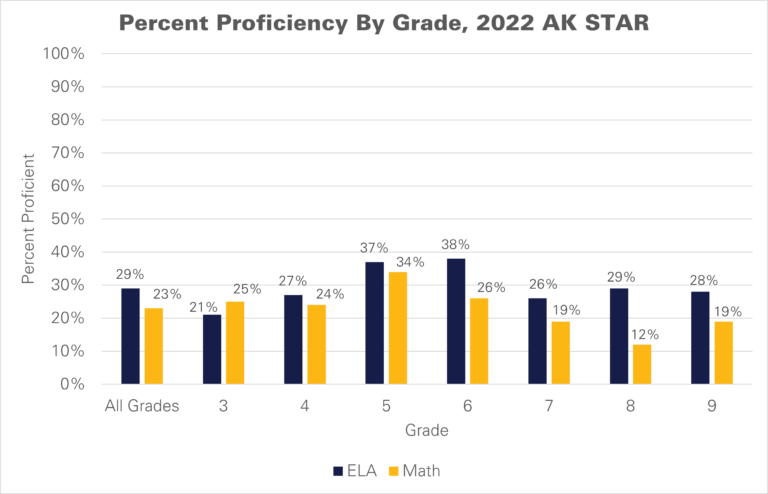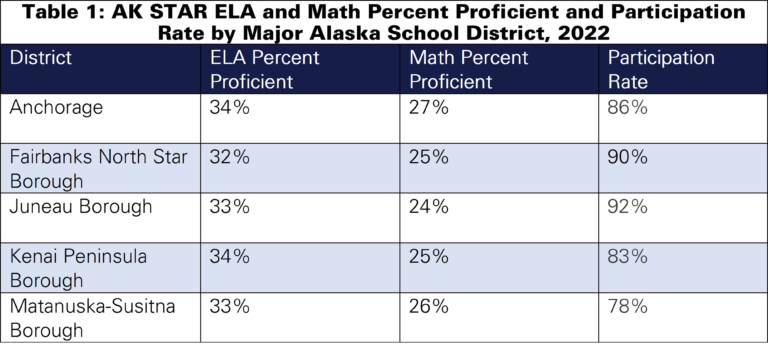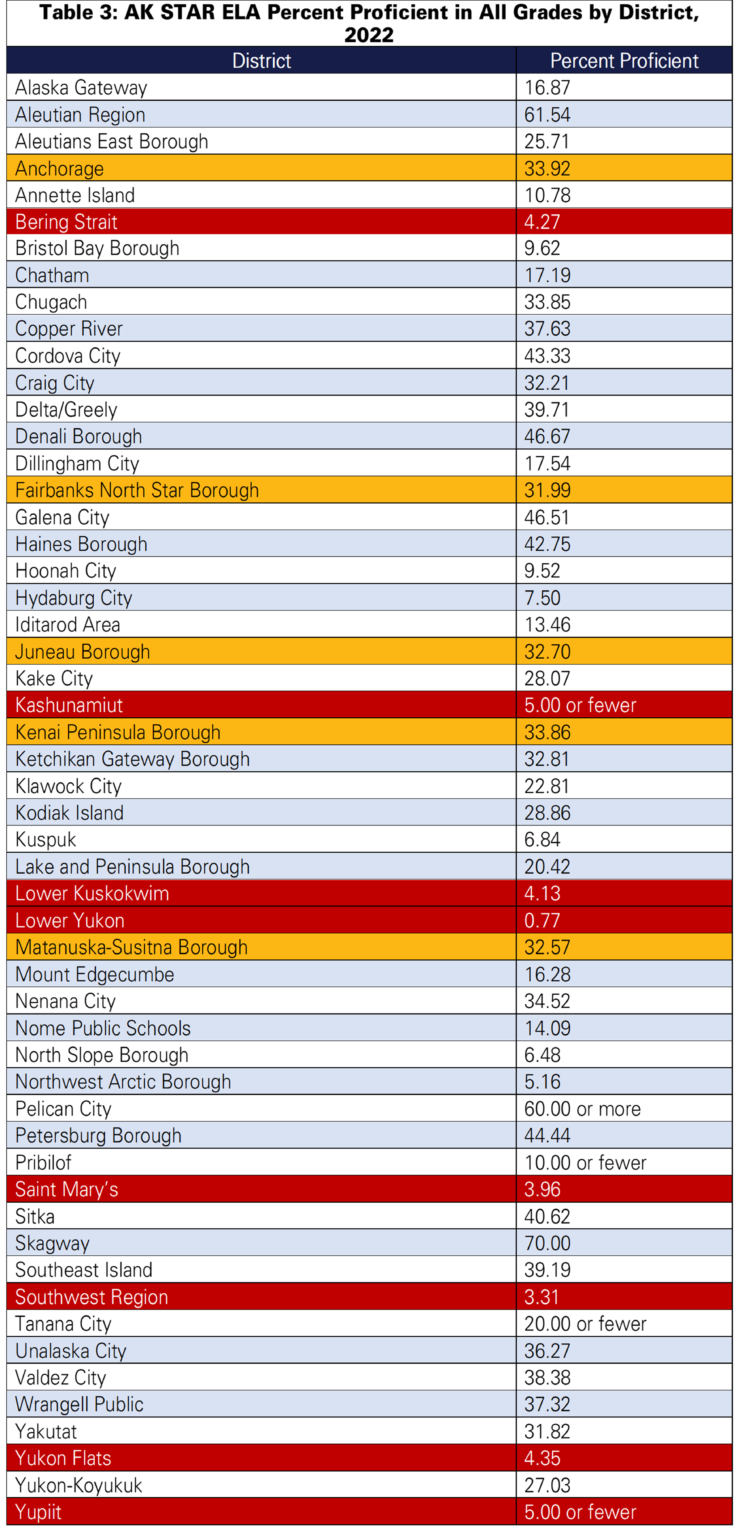
By Sarah Montalbano – Alaska Policy Forum
INTRODUCTION
Results from Alaska’s new statewide standardized assessment, the Alaska System of Academic Readiness (AK STAR), offer a glimpse of how Alaska’s students are doing post-pandemic. Although not directly comparable to the Performance Evaluation for Alaska’s Schools (PEAKS) ratings with which Alaskan parents might be familiar, the AK STAR still offers valuable information about the relative standings of Alaska’s schools and districts.
On the mathematics portion of the AK STAR, three out of four students were not meeting grade-level expectations. In conjunction with difficulties in reading, these results suggest that one-size-fits-all education no longer works — or never worked — for three-quarters of Alaska’s students. Public charter school students continued to outperform their counterparts in traditional public schools in both reading and math. Giving families more choices to find the kind of education that works best for them would immensely help Alaska’s students recover from learning loss.
KEY TAKEAWAYS
About 30% of all students were proficient in ELA statewide, and 23% were proficient in math. Although the exams are not directly comparable, proficiency has declined by almost 10 percentage points across all grades in both subjects since the 2021 PEAKS.
Eighth graders were the least proficient in math — with fewer than a thousand students statewide meeting eighth-grade standards — and third graders were least proficient in reading.
Of the five major school districts in Alaska, Anchorage reported the highest proficiency in ELA (34%) and math (27%).
In math, 36 schools reported 10% or fewer of their students proficient, while in ELA, 26 reported 10% or fewer of their students proficient. Results are not provided in more detail for very-low-performing schools for privacy reasons, so they may have up to 10% of students testing proficient, but they may have as few as zero students who do so.
Among districts, 11 reported 5% or fewer students proficient in math, while eight reported the same in ELA. This means some districts may have up to 5% of students testing proficient, but they may have as few as zero.
METHODOLOGY
The AK STAR assessment contains two sections, English language arts (ELA) and mathematics, which public schools are required to administer for students in third through ninth grade. Since 2016, parents have been allowed to opt their children out of standardized testing. The AK STAR exam was administered for the first time in the spring of 2022 in the hopes of reducing testing time and providing continual feedback via interim assessments.
AK STAR replaces PEAKS as Alaska’s standardized assessment. Proficiency rates between the two exams are not directly comparable because of differences in the tests’ design and cut scores. Results from PEAKS are available from 2017, 2018, 2019, and 2021.
Although the 2022 AK STAR exam participation jumped almost 15% from the corresponding PEAKS rate for 2021, the reported number was relatively low compared with pre-pandemic years. PEAKS 2019 reported almost 91% participation, while PEAKS 2021 only reported 65%. For the 2022 AK STAR exams (math and ELA), the statewide participation rates were both approximately 80%.
The Alaska Department of Education and Early Development (DEED) cautions against interpreting state- and districtwide results from the 2022 AK STAR as representative of all students in Alaska, citing a “significant disparity” between the participation rates of non-correspondence schools and correspondence schools (one of the state’s public charter school options). Nearly 93% of students in non-correspondence schools participated, while only 15% of correspondence school students did. While correspondence students aren’t well-represented by the data, students in traditional public schools are.
ALASKA WATCHMAN DIRECT TO YOUR INBOX
The switch in exams, the relatively low overall participation rate compared with pre-pandemic years, and the low participation rate of correspondence school students necessitate caution when drawing conclusions. However, it remains useful to compare relative standings between grades, districts, and schools, as well as to gauge the direction of progress. Parents and policymakers should continue to hold schools accountable for the quality of education they provided during the pandemic and their efforts to help students catch up.
As with PEAKS, the State of Alaska reports percent proficiency, or the portion of students testing proficient within a school or district divided by the total number of students tested (times 100). Proficient students meet or exceed the achievement-level descriptors (ALDs) for the subject. Proficient students test either “proficient” or “advanced,” while not-proficient students test at the “approaching proficient” or “needs support” levels.
Some schools must report their percent proficiency as a range because of privacy concerns with small numbers. These “suppression” rules are the same for AK STAR as for the PEAKS exam. If either achievement level (proficient or not proficient) contains between zero and two students, “the percentage of students at each achievement level will be reported as a range.” For schools with fewer than five students tested in total, no results are reported. This report excludes schools testing fewer than five total students.
Schools’ and districts’ reporting ranges imply that zero, one, or two students tested within that proficiency level (proficient or not proficient), because if both levels reported more than three students, exact percentages would be calculated. For proficiency levels reported as a range, such as “5 percent or fewer,” this report assumes the most-generous upper bound of five percent. However, the reporting protocol suggests the actual number of proficient students is much lower, probably in the single digits — a travesty for any school or district purporting to educate its students.
Figure 1 shows the proficiency ratings by school on the AK STAR exam. The PEAKS Data Map shows PEAKS proficiency ratings by school for 2018-2021 and AK STAR proficiency ratings for 2022. School markers are in their approximate geographic location. Schools marked in red report 51–100% of all grades below proficient on the ELA portion of the AK STAR. Schools marked in yellow report 31-50% of all grades below proficient on the ELA portion of the AK STAR. Schools marked in green report 0-30% of all grades below proficient on the ELA portion of the AK STAR. By clicking on a school marker, users can see the name of the school, ELA and math proficiency rates for all grades, and any available information about proficiency rates for specific grades.
Figure 1: AK STAR Proficiency Ratings by School, 2022

STATE-LEVEL FINDINGS
Statewide and across all grades, 70% of students fell below proficient in ELA, while 77% of students fell below proficient in math. Due to the change in examinations, direct comparisons cannot be made in proficiency rates between PEAKS and AK STAR. However, students have clearly lost ground: fewer students, 60% and 67%, were not proficient in ELA and mathematics on the 2021 PEAKS, respectively. The AK STAR uses “approaching proficient” and “needing support” as the two categories equivalent to “below proficient” and “far below proficient” on the PEAKS exam.
The percentage of students rated as not proficient in ELA on the AK STAR test is similar to the results of the most-recent NAEP exam, which found 76% of fourth graders and 74% of eighth graders not proficient.
Statewide, grade levels display a noticeable variation in proficiency in both subjects. Eighth graders were the least proficient in mathematics. Only 12%, or barely over 930 students statewide, met eighth-grade expectations in math. This is obviously concerning, given that eighth-grade math is foundational to high school mathematics — and to avoiding remedial math courses in college. That said, the result is inconsistent with the results of the NAEP exam, which found 28% of eighth graders proficient or advanced in math.
Third graders were the least-proficient grade in reading. Only 21% of third graders statewide met third-grade expectations in reading. Similar to math for eighth graders, reading by the end of third grade is crucial to students’ ability to learn other subjects in subsequent school years.
Figure 2 shows the 2022 AK STAR percent proficiency results by grade in both reading and math statewide. Sixth graders were the most proficient in reading, and fifth graders were the most proficient in math. In every grade except third grade, percent proficiency in math lagged reading. The grade with the largest gap in percent proficiency between reading and math was eighth grade, where the percentage of students proficient in reading exceeded those proficient in math by almost 17 points.
Figure 2: Percent Proficiency by Grade, 2022 AK STAR

DISTRICT-LEVEL FINDINGS
Skagway School District reported the highest percent proficiency in mathematics and reading. Almost 59% of the tested students were proficient in mathematics, and 70% were proficient in reading. Skagway was also the district with the highest percent proficient on the 2021 PEAKS exam, but with a higher percentage in both ELA (82%) and math (77%). Of its 71 enrolled students, almost 99% participated in both exams in 2022.
The district with the lowest percent proficient was the Lower Yukon School District, which reported 0.77% of its students proficient in ELA and 0.58% in math. Only eight students — of its total enrollment of 1,089 — were proficient in ELA, and only six students in math, with 95% of its students participating.
However, the Lower Yukon School District should share this dubious distinction with the three districts reporting “5% or fewer” proficient, as the suppression rules suggest that zero, one, or two students were proficient there. These districts are the Yupiit School District and Kashunamiut School District for reading and math, with Yukon Flats joining for math alone.
The five major school districts — Anchorage, Fairbanks North Star Borough, Juneau Borough, Kenai Peninsula Borough, and Matanuska-Susitna Borough — saw declines in the percentage of students proficient since the 2021 PEAKS exam. However, the change in the test format prevents determination of the size of declines. Nonetheless, all five districts performed within a narrow range of each other, with maximum differences of 2.0 percentage points in ELA and 3.5 percentage points in math. The Anchorage School District had the highest percentage of its students proficient in both ELA and math, at 34% and 27%, respectively.
Table 1 shows the five major school districts and the percentage of students proficient in ELA and math across all grades. Because ELA and math may have slightly different participation rates, the rate shown is the lowest of the two for that district.

KEY FINDINGS
Only one in five third graders are proficient in ELA at a time when mastery is crucial to the learning of other subjects in fourth grade.
Almost nine out of 10 eighth graders are not proficient in math and are unprepared for high-school mathematics.
In math, 11 districts reported 5% or fewer of their students testing proficient, while eight reported the same in ELA.
The lowest-performing district in Alaska, the Lower Yukon School District, only reported eight students proficient in ELA and six in math. However, several districts with suppressed statistics may have fewer than three students proficient in one or both subjects.
Resuming standardized testing in 2021 and switching to an assessment that can provide continual feedback across the school year were critical first steps to understanding the learning loss Alaska’s children suffered because of school closures and hastily implemented online/hybrid learning in 2020. Continuing to prioritize reading through careful implementation of the Alaska Reads Act will build a foundation of literacy for the future.
For many students, mathematics challenges undoubtedly justify additional remedial time and one-on-one tutoring, which unspent American Rescue Plan funds could help support. Yet, the most enduring lesson of another lackluster standardized assessment goes beyond pedagogy and funding: Schools aren’t working for three-quarters of Alaskan students. Strong charter performance offers hope to those families selected from long wait lists, but funding must follow students to the educational settings that work best for them.
GOING DEEPER
Table 2 lists the percentage of students in all grades proficient in math in Alaska’s 54 school districts, while Table 3 lists the percentage of students in all grades proficient in reading. Ranged results are presented as reported, the five major school districts are highlighted in gold, and the lowest-performing districts, those reporting proficiency of five percent or fewer, are highlighted in red.

————————————










13 Comments
Overwhelming statistics!!! Mike Dunleavy as a previous “educator”, and ought to be able to understand these facts! We are achieving the worst results! It’s not only that the system fails at basics of educating, but instead have become prolific at genitalia mutilation, schizophrenic behavior modifications, and desensitising for an overly sexed and godless leadership population!
Makes one ask what his achievement scores were.
I wonder if “Dung-leavy” thinks it’s okay to reward the public school system with an additional $1000.00 per student from our PFD .. I mean, they are doing such a great job
Interesting article Sarah, just hope the legislators read it.
We homeschool. Reading by age 2. Testing college level reading by age 9. But they can only count to two when it comes to the number of sexes.
Great, Bob.. We homeschooled as well, and they have proven exceptional in their gradient accomplishments, not only in family, but in the World of challenges.
Good for you too! One of the unexpected benefits was that our kids thank us nearly every day for not warehousing them at the government school. They talk with the kids going there and understand how much more freedom they have at home. We had none of the problems you hear about with children and adolescents – how hard it is, how rebellious they are. Nope. Instead they are very grateful and love their lives!
Give us more money so we can fail your kids better!
I grew up in Alaska schools and they were top notch.
Now they groom and poison and encourage white guilt and we pay them to do it!
Educational choice should be embraced for sure. We homeschooled. All are grown, past college, married and successful contributing citizens. We did have one though that did not read until age nine. Despite all my ‘tricks’ and proven ‘programs’. We ended up using an intense phonics based intervention that worked. There is a developmental variable and kids do progress at different levels. Hence why I do not care for the ‘egg crate’ model of grade levels and the proverbial round pegs into the round hole. this was developed for ‘herd’ management. That said, the same child went on to graduate from college in four years, with honors, and with a degree heavy on writing well. Now currently nearing the end of a masters program with straight A’s.
We learned along the way this child, now an adult, had an auditory processing glitch, affecting phonemic awareness and also the retention of math facts. Math concepts were easy, but the ability to memorize multiplication, even addition and subtraction, made for very very slow calculating. We wore out two sets of flash cards. Once this was identified there were helpful strategies.
I am not sure at the time this glitch was even on the radar of the public school system. This very bright kid likely would have been shoved into remedial programs early on, pulled out regularly and labeled. I am so glad we just happened to be home educating.. Parents should be making the decisions for the education of their kids, not bureaucrats.
No wonder. My son was passed up grades from fourth to ninth grade. He was told it didn’t matter if he failed, he would still be moved along. After all, it didn’t count until high school anyway. Needless to say, he wasn’t ready for high school at all. I homeschooled him during Covid, and he did fine. Then he went back to West and failed. He went to AMYA and got his GED. Enough fighting useless non-teaching by teachers who could not give one fat rat’s backside how he was doing or bothering to teach him so he could learn. And yet, here we are still paying for failing schools, even after this debacle. It has to stop.
Dunce cap governor are you reading the comments? How about you Todd Smolden? Or you Dave Stiren! What on this planet do the people have to say to get your attention on something relevant to our real lives? This administration is by far the most disappointing and disconnected I have ever seen by far!!!!
Take another swig!
I have lived in the Gateway school district for 30 years and became aware of these problems in 2003–2005
When I took my oldest out of The local school and home schooled him for a year so we could travel. He got top grades for the first time in his life. Upon our return to Tok he requested to go back to public school.
He had geometry under my guidance grade 6 and got a B. He had it again in grade 8 public school and failed.
I have two young boys now as I married a younger woman, and both are homeschooled, both are a year ahead of their classmates, and both maintain a 98.9 GPA.
Now public schools get about $5000 per student per year. If you were to pay that to the parents to stay home and school their own kids most would do it and their accomplishments would be through the roof!
More money won’t fix public education, parental control, direct daily involvement and quality curriculum is the only thing that will work.
Parents are going to have to find a way to step up to the plate because ultimately it’s Their responsibility to educate their children, not some paid strangers who ideology probably doesn’t jive with your own.
The Governor needs to have courage and govern. Governor Noem bannned CRT as did Governor DeSantis. One of the governors replaced the dishonest 1619 Project with the 1776 Commission that Trump put in place. One or more of the governors put in the 1776 Commission. I like the idea of giving school choice in some way. If parents are in control, there will be a huge academic gain. The scihools are not teaching character development and no moral standards as in traiditional, Western Civ. The NEA controls the Education, locally and natrionwide, and have a Leftist/Marxist agenda. This includes “dumbing down” so students will not be able to think logically. Also, history is revised and not true history. The leftist professors that are hired are Marxists. Truth is not important to them or to teach others. The KGB defector Yuri Bezmenov describes the 4 steps of brainwashing he had learned and applied in Russia to visitors to Russia. He wrote a book with a pen name Tomas Shuman titled LOVE LETTER TO AMERICA. We need to our children to recite the Pledge of Allegiance, listen to patriotic songs, We need to explain why America is so great. These are some of the many things that have been erased and phased out. True science needs to be taught. The true history of slavery. Black Economist Thomas Sowell wrote an essay titled “Facts About Slavery Never Mentioned in School. ” We grew up learning the classics like Shakespeare, learning about war heroes and great Conservative-minded leaders like Margaret Thatcher. There is a wealth of true information to be passed down. Ronald Reagan and Supreme Court Justice Scalia, who had 9 children had dinnertime discussions. Our family loves President Trump because he told the Truth. Our Grandchildren know that. We discuss the importance of honor, honesty, integrity, work ethic, attentiveness, Obedience, gratefulness, Diligence, orderliness, and many other virtues from the Bible. We can pass these on. Especially The Pledge of Allegiance which describes our country. Our country is capitalist and not leftist, socialist, marxist or whatever the latest label is for communism.,